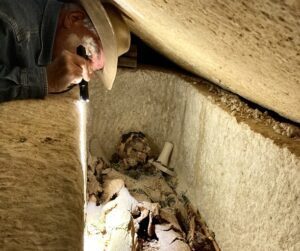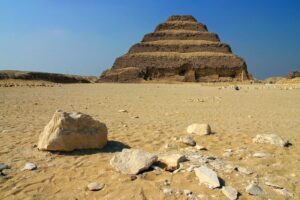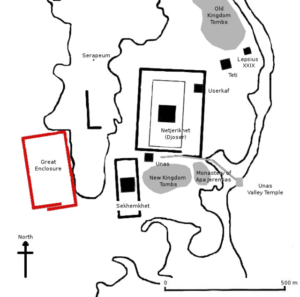
Editor’s Note: Here, Dr. Zahi Hawass, arguably Egypt’s most famous and celebrated archaeologist and egyptologist, recounts his recent discoveries at Gisr el-Mudir, also known as the Great Enclosure, one of the oldest stone structures known to date in Egypt, located at Saqqara and only a few hundred meters west of the Step Pyramid. Leading an excavation team, he uncovered evidence of a large cemetery consisting of tombs dated to the 5th and 6th Dynasties of Egypt’s Old Kingdom. What follows is his narrative in his own words:
________________________________
Our recent excavation at Gisr el-Mudir in the shadow of the Step Pyramid of Djoser, Saqqara, has revealed many amazing new discoveries, including: The recovery of nine beautiful statues of Messi, three statues and a false door of Fetek, another triad statue, a sealed sarcophagus containing a mummy covered with gold, and two more false doors and two additional tombs dated to the Old Kingdom.
A History of Discovery
The most important archaeologist who worked at this site was Zakaria Ghoniem, who discovered the pyramid complex of Skhem-Khet of the 3rd dynasty. This pyramid complex has been dated back to about 4800 years ago. While investigating in 1954, he explored the burial chamber of the pyramid, and found a completely sealed sarcophagus made of calcite alabaster. This was contemporaneous with a discovery made at Giza by Kamal El-Mallakh south of the great pyramid of Khufu — solar boats, found in two sealed pits with intact wood. (Kamal El-Mallakh was the architect who worked at Giza before he moved to work as a reporter in akhbar newspaper.) One of the boats was restored by the famous restorer, Hag Ahmed Youssef. Egypt’s then president Gamal Abdel-Nasser came to see the discovery of the boat based on a request from the famous writer and newspaper editor Mohamed Hussanien Heikal. Then, the delegation requested Nasser to go to Gisr El-Modier at Saqqara for the opening of the sarcophagus live in front of the press. Upon opening the sarcophagus, they found it empty.
This incident taught me a good lesson that I employed at Abousir. Here, Mirsolque Verner of the Czech Republic found an intact tomb of iuf-aa, who was anciently the director of the palace at the site, dated back to about 500 B.C. I called the Minister of Culture Farouk Hosni and told him about the discovery. He said that he would come with the press to open it live. I went to Verner and we brought the workmen and moved the tomb’s first sarcophagus, which weighed about 20 tons, and found under it another inscribed sarcophagus weighing about 10 tons. After moving the second one we found the third one, weighing 5 tons, which was inscribed, and then moved it, finding a beautiful mummy covered in green beads within a coffin. Then we placed everything back and asked the minister to come with the press and we officially opened all the sarcophagi, never having told him that we had already opened all the sarcophagi previously.
I began excavations at Gisr el-Mudir and found many Old Kingdom tombs, the most important of which was the tomb of the physician Qar. This tomb was small but beautifully decorated. Inside we found a group of surgical tools and outside about 30 Late Period statues, one of them belonging to Imhotep and the others for gods and goddesses. All of these objects are now inside the Imhotep museum in Saqqara. We stopped the excavation in 2011.
_______________________________

Excavations west of the Step Pyramid in Saqarra are revealing remarkable new finds. Pinzino, Pixabay
_______________________________

Map of the location of Gisr el-Mudir, the Great Enclosure, relative to the other major structures at Saqarra. Public Domain, Wikimedia Commons
_______________________________
New Excavations
The most recent excavations began with funding from Clovis Rossillon, who hails from a wealthy french family. Beginning in 2021 until January 2023, important major new discoveries were made. The first was a cache of nine beautiful statues, found southeast of Mastaba 4.
All images courtesy Zahi Hawass, unless otherwise noted.
[See the complete article with a premium subscription to Popular Archaeology.]


